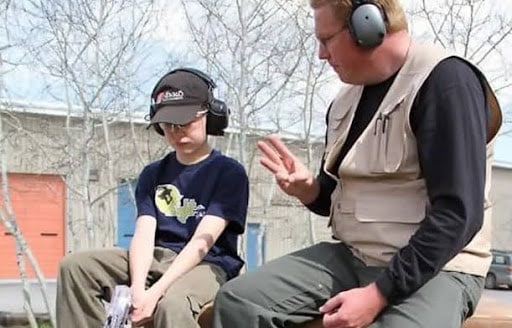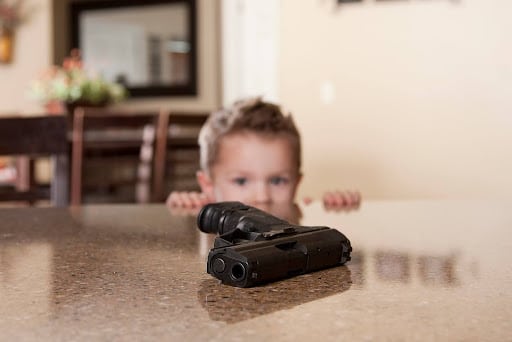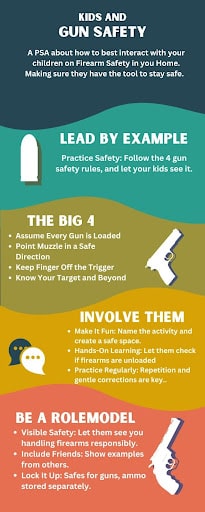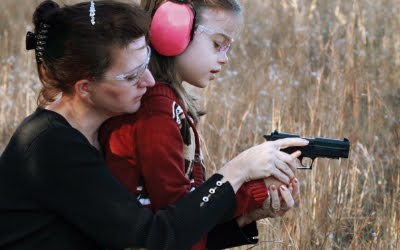
Posted on April 7, 2025
How to Train Your Kids on Gun Safety
By: Mitch Eckler
Kids are naturally curious, especially about the things they see us doing. This curiosity is a powerful tool when it comes to teaching them about firearm safety. They’re already engaged in something they find intriguing, and that’s half the battle when it comes to learning important safety lessons.
Now, before we dive into the details, I know there are some who believe kids should be kept away from guns entirely until they’re old enough to own them. And while I understand that viewpoint, there are certain things kids simply need to know—like how to safely cross a street, wear a helmet while riding a bike, and, yes, how to treat every firearm as if it were loaded.

For me, the priority isn’t that my kids learn how to shoot accurately or join me on hunting trips. The goal is to equip them with the knowledge of what’s right and wrong when it comes to handling a firearm. That way, if they ever encounter a gun, they know how to make sure no one gets hurt and recognize unsafe behavior so they can get out of there quickly.
The most important step in teaching gun safety is leading by example. Practice safe gun handling yourself—always. Your kids are watching, and what they see you do will set the standard for what they think is right.
Here are the four cardinal rules of gun safety to keep in mind and practice regularly, especially in front of your kids:
- Treat Every Firearm as If It Is Loaded: Always assume a firearm is loaded, even if you’ve just checked it. It’s a habit that needs to be automatic.
- Always Point the Muzzle in a Safe Direction: A safe direction means the bullet will harm no one if there’s an accidental discharge. Think about where your muzzle is pointed at all times.
- Keep Your Finger Off the Trigger Until You’re Ready to Shoot: This is about keeping your finger straight and off the trigger until you’ve made the conscious decision to fire.
- Always Be Sure of Your Target and What’s Beyond It: You must be absolutely certain about your target and what lies beyond it before shooting. It’s not just about the immediate target; it’s about everything in the bullet’s potential path.

Kids will be kids—they’re going to ask questions and make mistakes, and that’s okay. It’s all part of the learning process. When they see you handling firearms safely, they’ll naturally be curious. Use that curiosity to your advantage.
I find it helpful to turn gun safety lessons into a named event, like “Check Out the Guns.” This not only sets the stage but also helps shift their mindset from play to learning. When my son says, “Let’s check out the guns,” I know he’s ready to engage with a lesson. I start by clearing the firearm, showing him how it’s done, and then handing it to him so he can do the same. This reinforces that he needs to verify for himself that the gun isn’t loaded.
If you’ve got a named activity, why not create a specific spot for it too? For us, it’s the carpet by the laundry room—close by, away from distractions, and with no regular foot traffic. These little things matter because they help keep muzzle control issues to a minimum and give us a safe, out-of-the-way place to practice, even in a busy house.

From there, other fundamentals like trigger discipline and muzzle control start to fall into place naturally. Remember, corrections should be gentle and the tone should be light. They’re kids, they’re learning after all, and keeping the interaction fun will help the lessons stick.
Just like learning to ride a bike or tie their shoes, your kids won’t get gun safety right on the first try. It takes repetition and positive reinforcement. The more they see you handling firearms safely, the more likely they are to mimic those behaviors.
One of the best ways I reinforce these habits is by simply being consistent. I make sure my kids see me with my firearm—whether I’m practicing safe handling or just carrying it in my holster. It’s all about normalizing responsible gun ownership and demystifying firearms.
Sometimes, we’ll even turn it into a bit of a game. When we’re around friends who carry, my son might get a chance to handle a cleared revolver under close supervision, opening the cylinder and counting the charge holes while maintaining trigger discipline and muzzle control. These small, supervised interactions build familiarity and confidence in handling firearms safely. They also build confidence with other adults that he interacts with too.
At the end of the day, the biggest factor in your kids’ success with gun safety is you. It’s up to you to follow the rules—keep your firearms locked up, separate the ammo, and develop a system for success that anticipates the possibility of an accidental discharge.
I always say, “plan for the when and there won’t be an if.” By setting the example and consistently reinforcing safe behaviors, you’re equipping your kids with the knowledge and respect they need to stay safe around firearms.
Remember, gun safety isn’t just a one-time lesson—it’s a lifelong habit that starts with you. So, practice what you preach, keep the lessons engaging, and most importantly, stay vigilant. Your kids are watching, and they’re counting on you to lead the way.
Shoot safe!
—Mitch Eckler
For more content visit me at: youtube.com/@unclehangfire or you can find me on Instagram @the_bad_gunsmith.